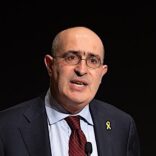Yom Yerushalayim? What’s that? The day each year that we celebrate the reunification of Jerusalem and probably one of the least known days in the Jewish calendar.
(This year the Hebrew date, Iyar 28, will fall out on May 8.)
A year living in Jerusalem recently was a good opportunity to think about what Jerusalem means to Jews today.
My generation used to see Jerusalem in 2D and in black and white. I grew up with the iconic image of three fresh-faced soldiers, heroes, looking up with awe at the newly recaptured Kotel. The soldiers in that photo spoke for the yearning of a people, for a long fulfilled dream and for a sense of history. It was an Israel where the filled swamps were still in living memory and orange groves were ubiquitous.
But times have changed. Those faces have aged, and the world is a different place. Jerusalem has changed, too. Not just the city but also the way we perceive it.
As befits its location at the meeting place of Europe and Asia, Jerusalem sometimes feels like Paris, and sometimes it’s more like Cairo. Jerusalem, 2,000 years later, seems still to be trying to figure out where it is.
Take a right on Uruguay and turn onto Guatemala. No, it’s not an international trip — it’s the residential neighborhood of Kiryat HaYovel, composed of streets that are named after countries that voted for the creation of the State of Israel in 1948. Even trying to pick up your child after a play date is a lesson in the history of the Jewish people.
Visible reminders of recent tragedies abound. One end of Emek Rafaim in the German Colony is the site of a suicide bombing of a cafe in 2003, the other of a bus explosion in 2004.
Jerusalem is now the poorest city in Israel — more than one-third of families in Jerusalem live in poverty, and more than half of the children in the city are below the poverty line.
Jerusalem is also about tensions; there is a struggle for the soul of the city. It is not just between Jew and Arab or between haredim (ultra-Orthodox) and the secular, though it is those, too. It is also about the tension between being a city and a symbol. God lives there but the garbage has to be picked up. It is hard to be a heavenly place and also to ensure that the potholes get fixed.
Jerusalem is more than just a symbol shrouded in stories and history and myths. It is also a complicated city struggling to keep its soul while ensuring that there is affordable housing for its residents and a decent quality of life for all who live there.
For many Israelis, Jerusalem is increasingly seen as a city of religion and government while Tel Aviv is the place to actually live. Put aside the political rhetoric and the reality is that Jerusalem is becoming a distant place from much of the rest of Israel. For me, even after all these years, driving up the winding road to Jerusalem is still an experience of coming a tiny bit closer to God. But many Tel Aviv residents would much prefer to go to Vienna. Our Israeli friends from North Tel Aviv made their second-ever trip to Jerusalem for our daughter’s bat mitzvah (“Why on earth would we want to go there?”).
The history of the Old City is more than the rebuilt Jewish Quarter. The monastery in the Armenian quarter still houses refugee families from the massacre of Armenians in 1915. The rooftops of the market area of the Muristan have been places to view the turmoil of Jerusalem over the centuries. The Austrian Hospice provides Viennese hot apple strudel in its secluded gardens hidden from the bustle. They, too, are all part of what makes up a city whose demographics are shifting rapidly.
More than 75 percent of children in the first grade in Jerusalem today are either haredi or Arab. They are part of Israel, and simple demographics shouts out to us that they also need to be part of the solution to the major social problems the city faces.
And all Jewish women must have a place to pray in a meaningful way in the spiritual center of the Jewish people, while secular Jews need to have places to have a coffee or go to a movie at the weekend.
That image of the soldiers in 1967 gazing towards the Kotel, and hopefully to a better future, is a deep part of the history of Jerusalem and a powerful message for our children. This Yom Yerushalayim, we should celebrate not only what that photo represents but also Jerusalem as it is now, with its diversity, with its internal conflicts and with its complexity.
The struggle for Jerusalem in the 21st century is different from the fight of the last one. The battle to combat debilitating poverty, to ensure that Jerusalem is a city in which its residents can live in harmony, and to make Jerusalem not just the center of the Jewish people but also of the people of Israel, are ones that need different weapons and soldiers.
That iconic photo on which I grew up might look rather different in 2013. It will not be in black and white and it’s not 2D. The Jerusalem of today is multi-dimensional, multicultural, cacophonous and in high-definition color.
In the struggle of today, the figures in that photo will also be Russian and Ethiopian. And maybe Arab-Israeli, haredi and include diaspora Jews, too.
Because what happens in Jerusalem matters to us all.
Gideon Taylor is a former executive in the Jewish nonprofit world. Today he works in the private sector.
The New York Jewish Week brings you the stories behind the headlines, keeping you connected to Jewish life in New York. Help sustain the reporting you trust by donating today.





